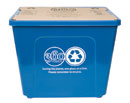
Alternative materials are bucking long-established trends to provide new packaging options for beer, wine and spirits.

An update on Nash’s classic might be: Candy is dandy, but liquor is dandier.
No product sector is immune from the recession, but alcoholic beverages are doing better than most. Sales are not rising as fast as they were, but they’re rising: U.S. wine sales were up 4.6% in 2008, domestic beer was up 2.9% and liquor 1.6%. (By contrast, bottled water sales were down 1%, and soft drinks down 3%.)
Continued vitality in alcoholic beverages means continued vitality in their packaging. Beer, wine and distilled spirits are moving forward in all aspects of packaging: design, alternative materials, more efficient handling, sustainability-and, yes, economizing.
When it comes to materials, glass still dominates in wine and is expected to do so for the foreseeable future. In beer, it has about a 43% share (cans have most of the rest), which is expected to stay about the same through 2017, according to The Freedonia Group ( see chart on p.22).
But the most noteworthy inroads against glass have been made in distilled liquor. In terms of total units, plastic containers, almost all of them polyethylene terephthalate (PET), have surpassed glass and now hold a 56% share, which is projected to rise to 69% by 2017. The total-unit number may be skewed because plastic dominates in the 187-milliliter (miniature, or “airplane”) size, which gives it more units per volume of liquor. But it still represents remarkable progress for a material that had only 23% of the liquor market in 1997.

"I'd much rather run PET than glass, but we understand that certain packages require glass."
Jim Zargo, president, McCormick Distilling
Jim Zargo, president, McCormick Distilling
McCormick started getting into PET in the mid-1980s, one of the first major distillers to do so. The company now uses PET for about three-quarters of its stock-keeping units (SKUs), and company president Jim Zargo declares that he greatly prefers it to glass.
“PET is a lot more economical than glass,” Zargo says. “On your line, there’s no breakage, no messing up your machinery, no safety issues. I’d much rather run PET than glass, but we understand that certain packages require glass from either a quality standpoint, consumer perception standpoint or the on-premise market request.”

"I think wine has that romance to it. When people go to dinner, you want to bring a nice bottle of wine. Can you imagine [a waiter] bringing over a PET bottle?"
Michael Othites, senior VP of operations, Constellation Wines U.S.
Michael Othites, senior VP of operations, Constellation Wines U.S.
Glass is class
That requirement goes to the heart of why glass has such a big share of the general alcohol market: its perception as a classy bottle material. Generally speaking, that’s why PET liquor bottles have been reserved mostly for larger sizes (1 liter and up) and/or less-than-premium brands. For such products, economy is a bigger issue than shelf presence.“Today, [distillers] may have five or six brand extensions, and those brand extensions tend to be more premium products,” says Kevin Stevens, vice president of North American sales and marketing for glass supplier O-I. “If they want to sell a premium product, if they’re going to twice distill something or twice mellow something and it’s a more expensive process, they want the package to convey that more premium image.”
This perception of “glass equals class” is nowhere more pronounced than in wine, where glass has a 93% market share on a unit basis. The dominance of glass is heavily tied to wine-related tradition, says Michael Othites, senior vice president of operations for Constellation Wines U.S.
“I think wine has that romance to it,” Othites says. “There’s the implement to remove the cork, there’s the shape of the bottle, the elegance of it. When people go to dinner, you want to bring a nice bottle of wine. Can you imagine [a waiter] bringing over a PET bottle? Someday maybe, but I think right now, wine is a different beverage from other alcohol products.”
Even within the glass category, tradition weighs more heavily in some wines than in others-literally. Consumers of expensive, high-end wines tend to prefer heavier bottles, which convey a sense of quality.
“There are certain wines, the very high-end wines, that, when you’re spending a lot of money, you want to feel some weight in that glass when you pick it up,” Othites says.
Lightening up
Less expensive wines, especially those that appeal to younger consumers, have more potential for lightweighting. Constellation has what Othites calls “lifestyle molds,” high-speed molds for lightweight glass bottles that are held and used by glass suppliers but are unique to the company. (Constellation, which has built up a large portfolio through acquisitions, has reduced the number of such molds from 83 to 26, simplifying changeover on its filling lines.)Mike Lonsway, O-I’s director of product development for North America, says the association of heaviness with quality is subsiding. “Most of our [wine] customers prefer the heavier bottle because consumers perceive that to be a better-quality wine,” Lonsway says. “But that mindset is changing quite a bit, just in the last several months.” O-I has been working on reducing weight in wine bottles through various means, including making the bottles shorter and reducing or removing the “punt”-the indentation on the bottom.
Although glass dominates the wine segment, other materials are ripening on the vine. Currently, paperboard has a 4.8% share of the market, while plastic stands at 1%. Freedonia predicts that by 2017, those figures will rise to 7.2% and 1.6%, respectively.
Paperboard packaging encompasses everything from single-serve style cartons to 3-liter bag-in-box. The two biggest advantages of paper packaging are convenience, especially for outdoor venues like picnics and concerts, and environmental friendliness.
“If you look at a Tetra Pak package versus glass, the product-to-package ratio is about, in the worst case, the product is 94% and the package is 6%,” says Debbie Dawson, Tetra Pak’s director of new business development. “Whereas with glass, it’s about 40-60 for a standard bottle.”
The Tetra packages in Constellation’s lineup are coming on strong, with sales up 63% in the 52-week period ending Feb. 22. Constellation’s Black Box, a 3-liter bag-in-box of premium wine, is another big seller, up 46% in the same period.
A big part of the appeal of this non-traditional wine packaging is to “millennials,” ages 21 to 35. These are the kind of consumers who are more likely to be attracted to “fun” concepts like Constellation’s Twin Fin wine, which features graphics of a surfboard.
“They don’t want to take their wine so seriously,” Othites says. “They want to make wine simple, easy and fun.”

"Overall, the bottle remains the traditional preferred package for beer."
Dave Klante, VP of engineering and packaging, MillerCoors
Dave Klante, VP of engineering and packaging, MillerCoors
Brew-ha-ha
Beer is an alcoholic beverage that is pretty much synonymous with fun. It’s unique in several ways: It’s the highest-volume alcoholic beverage in America (and the world); it’s one of the most concentrated of all major U.S. products (the two leading brewers, Anheuser-Busch and MillerCoors, account for more than three-quarters of the total U.S. beer market); and in terms of packaging materials, it’s almost evenly split: 56% for metal cans, 42% for glass bottles.Bottles and cans each have distinct advantages, says Dave Klante, vice president of engineering and packaging for MillerCoors.
“Glass bottles are the preferred package for on-premise and where image is considered enhanced with a bottle and the tactile feel of a cold bottle are preferred,” Klante says. “Overall, the bottle remains the traditional preferred package for beer.”
On the other hand, cans are preferred for off-premise consumption. They’re lighter, faster to cool and easier to dispose of than glass bottles.
Cans also are more efficient from a production standpoint, Klante says. They run up to 2,200 containers per minute (bottles top out at about 1,500), and have higher efficiencies in handling, filling, shipping and warehousing.
MillerCoors’ recent packaging innovations have been evenly split between bottles and cans. Two of these have to do with marketing Coors as a “cold-tasting” beer. Thermochromatic inks change color when the beer is cold enough to drink; these were introduced on bottle labels last year and will be coming out on Coors cans shortly. A “frost-brewed liner” for the interiors of Coors cans keeps the beer from touching the aluminum walls, insulating it to keep its chill longer. Other innovations include a resealable 16-ounce aluminum bottle for Miller Lite and a “peel and reveal” label for back panels of some Miller bottles, tying in to on-premise promotions.
Able labels
When it comes to beer labels, the market has seen some fundamental changes, says Dan Muenzer, vice president of Spear Inc. More than half of Spear’s revenue comes from beer labels.Until fairly recently, cut-and-stack paper labels, sometimes metallized, were the rule in beer. But then pressure-sensitive labelers got faster and became able to keep up with high-speed fillers. That gave brewers the option of putting P-S labels on the bottles in their breweries after pasteurization, which conferred two advantages. They were able to use P-S labels without prelabeling the bottles, which increased their production flexibility. And they could use less expensive water-based acrylic adhesives, because the labels were no longer passing through the pasteurizer; prelabeled bottles needed a stronger, more expensive solvent-based adhesive.
These factors, along with rising volume for P-S, are helping close the gap between P-S and paper, Muenzer says. For high-volume applications, P-S is down to about 50% more than paper. This puts the aesthetic advantages of P-S labels within reach; the polypropylene label material simply has more graphics potential than paper.
Bulking up
Another potential important change with beer has to do with secondary packaging. Most beer bottles in the U.S. are filled under a “re-shipper” system. The empty bottles come to the brewery inside carrier baskets, usually six-packs, that are fitted inside corrugated cases. The filling lines pluck the bottles from these “re-shippers,” fill and seal them, then place them back in the baskets inside the cases, which are glued or taped shut and shipped.
This arrangement saves on space and personnel, Klante says, since basket and case erectors are not needed.
The alternative is shipping the bottles to the brewery in bulk, palletized on slipsheets without cases. The baskets and cases arrive as blanks and are erected on-site. MillerCoors uses this bulk system too, Klante says. Its advantages include more economical shipping for the glass and secondary packaging, and increased flexibility.
The bulk system for beer is common outside North America, and is just starting to take hold in the U.S., says Jim Wagner, director of beverage marketing for paperboard and machinery supplier MWV. Bulk glass is used extensively here for 12-packs and other non-standard retail sizes, but most lines for the most common U.S. size-six-pack, 24-case bottles-use re-shippers.
To go with bulk glass systems, MWV supplies equipment that erects a basket around a cluster of filled bottles and glues it shut. “So there is a cost savings and a sustainability story, because you’re cutting down moving empty bottles in baskets in cases,” Wagner says.
Re-shippers are commonly used for spirits also. McCormick Distilling uses them for its glass bottles, because of equipment issues: There isn’t room in the plant to install the divider inserter that a bulk glass system would require.
But about two years ago, McCormick went to bulk receiving for the PET bottles that form the majority of its packaging. For shipping, the plant uses special corrugated cases from Smurfit-Stone, trade-named Meta, that feature angled corners. These hold the plastic bottles snugly, without dividers, and the strengthened corners allow the cases to stack safely on a pallet.
The relative prosperity of the alcoholic-beverages segment gives it a little more room to make packaging progress than other product sectors. Alternative materials, for both primary and secondary packaging, are shaking up the category and providing good opportunities for economy and sustainability.
This arrangement saves on space and personnel, Klante says, since basket and case erectors are not needed.
The alternative is shipping the bottles to the brewery in bulk, palletized on slipsheets without cases. The baskets and cases arrive as blanks and are erected on-site. MillerCoors uses this bulk system too, Klante says. Its advantages include more economical shipping for the glass and secondary packaging, and increased flexibility.
The bulk system for beer is common outside North America, and is just starting to take hold in the U.S., says Jim Wagner, director of beverage marketing for paperboard and machinery supplier MWV. Bulk glass is used extensively here for 12-packs and other non-standard retail sizes, but most lines for the most common U.S. size-six-pack, 24-case bottles-use re-shippers.
To go with bulk glass systems, MWV supplies equipment that erects a basket around a cluster of filled bottles and glues it shut. “So there is a cost savings and a sustainability story, because you’re cutting down moving empty bottles in baskets in cases,” Wagner says.
Re-shippers are commonly used for spirits also. McCormick Distilling uses them for its glass bottles, because of equipment issues: There isn’t room in the plant to install the divider inserter that a bulk glass system would require.
But about two years ago, McCormick went to bulk receiving for the PET bottles that form the majority of its packaging. For shipping, the plant uses special corrugated cases from Smurfit-Stone, trade-named Meta, that feature angled corners. These hold the plastic bottles snugly, without dividers, and the strengthened corners allow the cases to stack safely on a pallet.
The relative prosperity of the alcoholic-beverages segment gives it a little more room to make packaging progress than other product sectors. Alternative materials, for both primary and secondary packaging, are shaking up the category and providing good opportunities for economy and sustainability.
FOR MORE INFORMATION
The following companies contributed to the research of this article:MWV
804-327-5200;www.mwv.com
O-I
567-336-5000;www.o-i.com
Smurfit-Stone
312-346-6600;www.smurfit.com
Spear Inc.
800-627-7327;www.spearinc.com
Tetra Pak Inc.
800-806-9675;www.tetrapakusa.com

FROM THE LIQUOR SHELF
Alcohol has always been a segment where, in many cases, designers have a freer-than-usual reign. Relatively high margins and a need for strong shelf presence help enable and motivate uniqueness in alcohol packaging design.Here are some of the more interesting packages that we’ve run across in the last few months.
Absolut-ly clear: Absolut Mango, the most recent addition to the vodka line from Pernod Ricard USA, is in a 750-milliliter glass that’s more transparent than previous varieties. The decoration consists of mango fruit contours gathered in groups around the bottle.






WEB EXCLUSIVE: Fancy tequila gets fantástica bottle
There’s nothing like a Mexican bottle for Mexican tequila. And when it’s unique, artisanal tequila, Mexico is a great place to get a unique, artisanal bottle.That’s what Jonathan Rojewski and Lincoln Mayne discovered when they founded Tanteo Tequila about two years ago. The company’s sole product, in three flavors, is distributed in the New York City area, with about 80% of sales on-premise and the rest in retail (suggested price about $45).
Mayne bartended his way through design school, which gave him an appreciation for ergonomic design in liquor bottles: “I wanted to present something that was really functional and ready to use, but not let that dictate the way it appeared.” He also wanted to distinguish Tanteo from what he calls the “dark emotion” and “gothic traits” that suffuse most tequila bottles, with their squat shapes and cloudy glass.
Tanteo features clear glass, broad shoulders and an elongated neck. It handles better than the typical squat tequila bottle, partly due to rings on the neck that help the bartender get a good grip. “Bartenders will use a brand that they are comfortable holding on to for an eight-hour shift,” Rojewski says.
The bottle comes from a Mexican specialty producer that combines a mold with lung power from a two-person team to blow each bottle. The resulting glass, 100% recycled, has slight “imperfections”-bubbles in the glass, minute variations in the neck and base-that make each bottle unique. The seal above each label is hand-stamped with wax imported from France and stamps custom-carved in England.
“When we made a decision that we wanted to have that style of glass, you’re really limited pretty exclusively to Mexico,” Rojewski says. “Big glass production places don’t make glass like this.” The Tanteo bottle has won silver awards from the World Beverage Competition and the Beverage Testing Institute.
